Eagle’s Bridge in Sofia – Boiling Point
Everybody in Sofia knows Eagle’s bridge. It is a starting point of many explanations how to reach a place in Sofia.
Probably the reason is because many public transport buses have a stop there.
Sofia public transport is memorable experience, but this is another story :-).
Article by Ali Grigorova
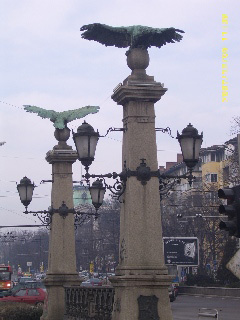 |
We are slowly approaching Eagle’s Bridge in Sofia. There I will leave Tsarigradsko Shose Blvd. and will head towards another big line of cars and buses in another traffic jam.
Exactly that bridge is the boiling point with the highest tension of my journey.
That place is really vivid from dawn till dusk.
People transfer from one bus to another, cross the boulevard incorrectly; some drivers get into the way of other drivers and cross the streets on red light.
The former ‘gate’ of Sofia is now far into the inside of the town and by the time you get to it, you have already become sick of the traffic in the capital :-).
Eagle’s Bridge is maybe the busiest juncture in the center of the capital.
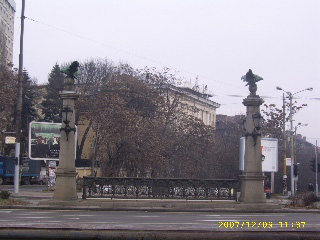 |
After entering Sofia from the East side by Tsarigradsko Shose Blvd (you use that boulevard also when you arrive at the airport), Eagle’s Bridge is the first crossing you have to stop at.
There are beautiful bronze bas-reliefs at the bottom end of the columns, on the top of which the proud birds are situated.
This place is the beginning of the perfect center. You will be thoroughly inspected by 4 bronze eagles with threateningly outspread wings at the four ends of the bridge when passing by it.
Exactly those statues give the name of the bridge – Eagle’s Bridge. Those are its symbols and ‘keepers’.
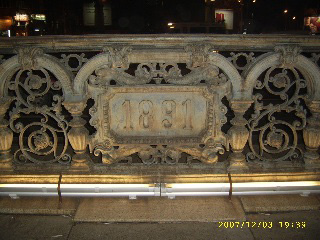 |
The bridge is built in 1891. It is a symbol of freedom because at that place for the first time in 1888 the prisoners from Diarbekir are welcomed (in that Turkish town figures from the Bulgarian National Freedom Movement of the 19th century have been sent in exile).
The architects of Eagle’s Bridge are Arnold Colar and Vatzlav Prosek. Beneath the juncture are the waters of Perlovska River. They pass through the whole city.
If you hear that someone will ‘pass by the canal’ that means that he will drive/ walk on the street/ sidewalk parallel to the river. That’s how the citizens of Sofia call it – ‘The Canal’. Actually very few of them know its real name.
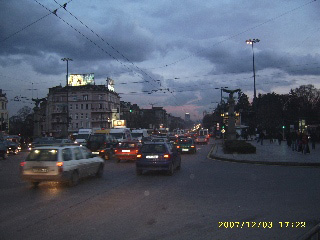 |
At Eagle’s Bridge the traffic jam is all day long. After the city of Sofia wakes up thousands of people and cars head towards that point as part of their way to the workplaces.
Here we have a stop for over 10 buses and 4 trolley buses that connect the 4 ends of the capital. Tsarigradsko Shose Blvd is crossed here with another main line of communications of Sofia – Evlogi Georgiev Blvd.
The traffic is worst between 8 a.m.-11 a.m. and 5 p.m. – 8 p.m. While being into the traffic jam you can see the sights of the region around Eagle’s Bridge.
If you come from the airport in order to reach the Sofia city center you will pass by Tsarigradsko Shose Blvd for sure or as the citizens of Sofia call it ‘Tsarigradsko’.
This is the biggest and longest boulevard in the capital. It begins its way from Eagle’s Bridge and flows in Trakia highway. Here the cars drive faster.
It’s the only boulevard in Sofia at which you are allowed to drive with a speed of 80 km per hour (actually even if you want to drive with that speed at the other boulevards it will be impossible because of the traffic jams).
That’s why it is extremely dangerous to drive on it. Subways are built for the pedestrians at the bus stops.
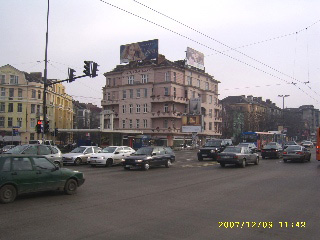 |
On the right hand side, just before Eagle’s Bridge is situated ‘Tzarevetz’.
In front of that building, coloured in a strange pink colour (they have recently painted it like that), many young people arrange their dates.
‘Tzarevetz’ is built in 1930 from architect Gechev. Just next to it is ‘Asenovetz’ coloured in yellow.
On the left hand side is the artificial lake ‘Ariana’. The construction of the lake starts in 1879 with the project of engineer Markov.
In the beginning of the 80’s it is drained because the water from it has soaked and flown into the subway under Eagle’s Bridge.
This year (2007) ‘Ariana’ was restored. The small bridge that was built at the time of prince Ferdinand (1861 – 1948 – Ferdinand I, prince and king of Bulgaria) is restored as well.
During the winter ‘Ariana’ is drained and becomes a winter slide with an area of 1200 square meters. That is why if you plan to visit Sofia during the winter, don’t forget to take your skates with you. Of course you can rent a pair at the lake for 3 levs per hour.
Here are organized holiday attractions During the Christmas and New Year’s holidays. If you come during the summer you can drink beer drifting freely over the water in ‘floating couches’ or you can ride a water bike.
